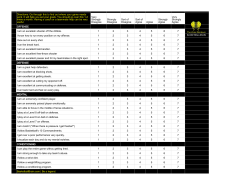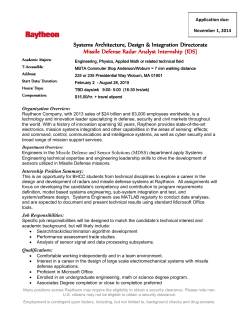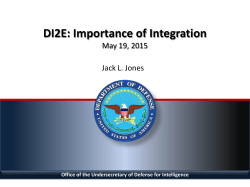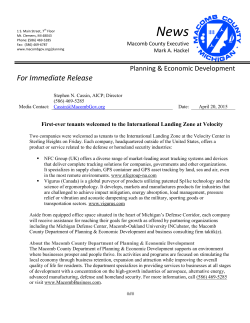
Rebuilding Deterrence - Project 2049 Institute
Rebuilding Deterrence Post-2015 Defense Guidelines Challenges Facing the U.S.-Japan Alliance Sugio Takahashi May 2015 About the Author Sugio Takahashi is a Senior Fellow of the National Institute for Defense Studies and currently Deputy Director of the Office of Strategic Planning of Ministry of Defense in Tokyo, Japan. Mr. Takahashi has published extensively in the areas of nuclear strategy, the Japan-U.S. alliance, and East Asian regional security, including “Implications of Recent Challenges in Nuclear Deterrence on Japan’s Security: NPR, New START, “The World without Nuclear Weapon,” and Extended Deterrence,” Kaigai Jijo, Vol. 58, No. 7/8 (July 2010) (in Japanese); “Transformation of Japan’s Defense Industry? Assessing the Impact of the Revolution in Military Affairs,” Security Challenges, Vol.4, No.4 (Summer 2008); “Dealing with the Ballistic Missile Threat: Whether Japan Should Have a Strike Capability under its Exclusively DefenseOriented Policy,” NIDS Security Reports, No.7 (December 2006). Sugio Takahashi has a B.A. and a M.A. from Waseda University and a M.A. from George Washington University. Cover image source: U.S. Pacific Command About the Project 2049 Institute The Project 2049 Institute seeks to guide decision makers toward a more secure Asia by the century’s mid-point. Located in Arlington, Virginia, the organization fills a gap in the public policy realm through forward-looking, region-specific research on alternative security and policy solutions. Its interdisciplinary approach draws on rigorous analysis of socioeconomic, governance, military, environmental, technological and political trends, and input from key players in the region, with an eye toward educating the public and informing policy debate. | Post-2015 Defense Guidelines Challenges Facing the U.S. Japan Alliance | Introduction On 27 April 2015, Japan and the U.S. concluded the new Guidelines for the Japan-U.S. Defense Cooperation (hereafter, Defense Guidelines). 1 The Defense Guidelines is a framework document designed to specify operational areas of the defense alliance and to set a division of labor of such operations. With the new Defense Guidelines concluded, the military-level planning process can begin. Eighteen years have passed since the previous Defense Guidelines revision was concluded. Since then the regional and global security situation has changed drastically, most notably in the following four ways: (1) North Korea has steadily continued to develop nuclear weapons and ballistic missiles; (2) China has accelerated its military modernization; (3) Japan has revised her capstone strategy document (the National Defense Program Guidelines (NDPG) three times; and (4) the U.S. has published the Quadrennial Defense Review (QDR) four times. The Defense Guidelines, in retrospect, may have needed to be revised even earlier then it was. Now that the document has finally been signed, it is imperative that substantive deliverables follow in a timely manner. Key for the alliance is implementation of the agreement to adapt to the strategic transformation unfolding in this region. This paper will explore the challenges facing the alliance after the revision of the Defense Guidelines. It will examine the evolution of Japanese thought on deterrence as outlined in the 2010 and 2013 NDPG. It will also assess the strategic implications of China’s military modernization. This paper will conclude by offering possible policy solutions to the challenges facing the U.S.-Japan alliance in maintaining deterrence. Evolution of Japan’s Thoughts about Deterrence Japan’s defense strategy is addressed in the NDPG, which is the capstone document of Japan’s defense policy. The NDPG is similar to the American QDR. The NDPG analyzes Japan’s security environment; defines roles, missions, and capabilities for the JSDF; and sets 10-year objectives for future force structure. Japan has revised the NDPG twice in recent years, in 2010 and 2013, to keep pace with a changing security environment in East Asia. The 2010 NDPG introduced the key concept of a “Dynamic Defense Force,” which consists of readiness, mobility, flexibility, sustainability, and versatility reinforced by advanced military technology and intelligence capabilities. The concept emphasized “dynamic deterrence,” for deterring security challenges within “gray zones” between peacetime and wartime, rather than deterring high-end conventional military conflict. It is based on perspectives of the strategic trends and environment in East Asia in 2010, 1 | Post-2015 Defense Guidelines Challenges Facing the U.S. Japan Alliance | most notably the trend of a regional power engaging in opportunistic, creeping expansion to gradually change the status quo by taking advantage of windows of opportunity. This was viewed as more concerning than a high-end conventional amphibious invasion. According to deterrence theory, there are some situations in which deterrence hardly works, including fait accompli and probing.2 Fait accompli is a situation where the adversary adopts a strategy through which it attempts to change the status quo without giving enough time for a deterrer to react. Probing is a situation where the adversary is challenged to find the lowest ceiling of deterrence commitment. China’s opportunistic and creeping expansion in the East China Sea and the South China Sea exactly fits these two challenges. By definition, these Chinese advances are difficult to deter. To counter creeping expansion, the 2010 NDPG minted a concept of “dynamic deterrence” to complement a traditional deterrence posture that is designed to deter high-end conventional conflict. 3 Through continuous steady-state intelligence, surveillance, and reconnaissance (ISR), information gathering, military exercises, and demonstration of operational effectiveness and readiness, dynamic deterrence is intended to sensitize a challenger to the notion that they are always being watched, and that there are no physical gaps of defense posture, or “windows of opportunity,” for fait accompli or probing. In September 2012, two years later after the 2010 NDPG was released, the Government of Japan purchased the Senkaku Islands from a Japanese private citizen who owned the islands. Since that time, China has continuously dispatched government vessels near the Senkaku Islands, even though Japan did not operationalize defensive measures on the islands. Even without tensions related to the Senkaku situation, however, the security environment around Japan had already become more severe. China had continued to modernize its air and naval forces, and intensified its maritime and air activities. North Korea had made significant progress in developing nuclear weapons and missiles. Japan had experienced the Great East Japan Earthquake of March 2011, and the SDF had acquired a lot of lessons learned from the disaster relief operation. These dynamics demanded that the Government of Japan review the NDPG again. This led to the release of a new version in December 2013. Similar to its predecessor, the 2013 NDPG emphasized gray-zone security challenges, stating, “There are ongoing regional conflicts involving various countries as well as an increase in the number of so-called ‘gray-zone’ situations, that is, neither pure peacetime nor contingencies over territory, sovereignty and maritime economic interests.”4 It also expresses the concern that such gray-zone security challenges in the Asia-Pacific region “tend to linger, raising concerns that they could develop into more 2 | Post-2015 Defense Guidelines Challenges Facing the U.S. Japan Alliance | serious contingencies.” In other words, the 2013 NDPG recognizes that the “gray-ness” of gray zones had become darker since the 2010 NDPG was formulated. In this context, the 2013 NDPG redefined deterrence against gray-zone security challenges. The common foundation of the notion of deterrence in both NDPGs is the importance of not only developing the capability to respond to a high-end conventional conflict, but also to promote the continuous operation of the defense force during peace time to make the other party aware of one’s intentions and capabilities. This ensures effective deterrence to cope with gray-zone security challenges and avoid kinetic conflict. The difference of the baseline situation between these two NDPGs is that the 2013 NDPG was drafted after China started to demonstrate its intention to send government vessels to change the status quo. The 2013 NDPG therefore sought to create not just “deterrence,” but also to use escalation management in “response to such challenges.” Although it remains as important as ever to deter gray-zone security challenges through “dynamic deterrence,” it is particularly important to control the risk of escalation when promoting effective deterrence and responding to situations. Deterrence in gray-zones was redefined in the 2013 NDPG to adapt to the changing situation. The adapted notion of deterrence includes three elements: 1) having ISR capabilities for situational awareness and real-time information sharing to swiftly respond to deliberate or accidental escalation; 2) having the ability to conduct various ranges of operations to clearly convey Japan’s intentions and to make the other party aware of Japan’s proficiency to respond to escalation of the situation: and 3) have the ability to adeptly respond to the situation when escalation does occur. A new part of 2013 NDPG was the addition of a notion similar to the U.S. notion of flexible deterrent options (FDO). FDO is intended to strengthen deterrence by swiftly conducting the repositioning and maneuvering of military assets, including exercises in order to send a signal to the other party. Implementation of FDO will, for example, require the preparation of various options for responding to small-step escalation depending on how the situation develops. In this regard, the 2013 NDPG states, “Japan will regularly conduct persistent ISR activities and…the SDF will conduct strategic training and exercises in accordance with the development of the situation and swiftly build a response posture including advance deployment of units in response to the security environment and rapid deployment of adequate units. Thus Japan will demonstrate its will and highly developed capability to prevent further escalation.” 5 Following the 2013 NDPG, the new Defense Guidelines mentions allied FDO. In this way Japan has evolved its notion of deterrence, focusing especially on the “gray-zone” that exists between pure peacetime and wartime. 3 | Post-2015 Defense Guidelines Challenges Facing the U.S. Japan Alliance | Strategic Implications of PLA Modernization China continues to rapidly expand its defense expenditures. The focus of Chinese military modernization is to develop anti-access/area-denial (A2/AD) capabilities and strategic strike capabilities including nuclear, space, and cyber capabilities. 6 In addition to procuring modern platforms, the PLA and China’s paramilitary forces have increased the frequency and geographical scope of their everyday operations in East Asia.7 China is trying to use fait accompli to gradually transform the status quo, mainly by employing paramilitary forces both in the South China Sea and the East China Sea. In the Western Pacific, PLA naval and air assets have gradually expanded their operations as well. China is using creeping expansion while cautiously avoiding escalating to the level of outright military conflict. The parallel developments of conventional military force modernization for A2/AD on the one hand, and creeping expansion with paramilitaries on the other, has serious implications for the region’s strategic environment. First, these developments have implications not only for the military-to-military balance, but perhaps even more importantly, for the most important area of strategic competition found today: a paramilitary-to-paramilitary showdown. China has continuously sent its coast guard vessels into Japan’s territorial waters near the Senkaku Islands since September 2012. This challenge to the status quo is carried out by the Chinese coast guard rather than military forces. In South China Sea, as well as the East China Sea, the main assets used by China for its creeping expansion is its paramilitary forces. This paramilitary-first approach has some benefits for China. First, this approach reduces the risk of escalation to military conflict even when China challenges the status quo. Second, since very few Southeast Asian countries currently have significant coast guard forces, there is a possibility that Southeast Asian countries will mobilize military forces to counter China’s paramilitary force. If that occurs, China can blame those countries as “escalating the situation” and further justify their mobilization of military forces. The second implication of China’s parallel development of military modernization and creeping expansion is that creeping expansion can actually reinforce A2/AD capabilities. For example, China has begun to build airstrips and port facilities through land reclamation in the middle of the South China Sea, at locations such as Gaven Reefs, Cuarteron Reef, Hughes Reef, and Fiery Cross Reef. If these construction projects are completed and military forces begin to use these facilities, China’s A2/AD range and ISR capabilities for targeting will be multiplied. China’s ability to control escalation based on its initiative would enhance its deterrent against intervention by an external military power such as the U.S. By combining military modernization for A2/AD and creeping expansion, China can effectively challenge and transform the regional status quo. 4 | Post-2015 Defense Guidelines Challenges Facing the U.S. Japan Alliance | The third implication relates to China’s modernization of its nuclear forces. Currently, the main pillar of China’s strategic nuclear force is its road-mobile ICBM. In addition, China is developing submarine launched ballistic missiles (SLBMs) and ballistic missile nuclear submarines (SSBNs) to develop a maritime leg of its strategic nuclear force. China’s efforts to acquire a maritime strategic nuclear force are assumed to be intended for developing an invulnerable nuclear second-strike capability. However, China has already achieved this capability through land-based, road-mobile ICBMs. The development of SLBM/SSBN would add an invulnerable second strike capability, but would not be a game changer. A more serious potential game changer for regional security is how the U.S. responds to China’s nuclear modernization. If the U.S. officially accepts the existence of mutual vulnerability between the two countries it may cause deterioration of the regional security environment through the “stability-instabilityparadox.” The “stability-instability-paradox” is a paradoxical situation in which mutual deterrence at the strategic level causes one party’s aggressive behavior at the regional level because that party feel assured that the counterpart would refrain from responding to their aggressive behavior to avoid escalation to a level of mutual destruction. If the U.S. explicitly accepts mutual vulnerability with China, this, when combined with China’s A2/AD capability, could cause China to feel that it has built a robust deterrent against the U.S. at the strategic level. China may be encouraged to increase its aggressive creeping expansion in the East China Sea and the South China Sea. Enhancing Allied Deterrence The U.S.-Japan alliance should reconstruct its deterrent at three levels to prepare countermeasures against these potential strategic effects of PLA modernization. First, the alliance should enhance the credibility of nuclear deterrence, and the U.S. should not explicitly accept the notion of mutual vulnerability with China. While China already has a certain degree of nuclear second strike capability against the U.S. with its roadmobile ICBMs, its nuclear strike capabilities are limited. China lacks the counter-force capability held by the U.S. and Russia. If the U.S. were to “admit” the U.S. and China are mutually vulnerable, it would be overlooking the qualitative asymmetrical advantage gained from its counter-force capability. Moreover, it may cause a “stability-instabilityparadox.” The current U.S. position on this issue, manifested in the latest Nuclear Posture Review of 2010, is ambiguous and along the lines of “neither confirm nor deny,” Chinese capabilities, while it explicitly implies mutual vulnerability with Russia. The continuation of this position is very important for regional deterrence. Second, the alliance should work to find a solution to the competing demands of responding simultaneously both to creeping expansion and the A2/AD threat. To 5 | Post-2015 Defense Guidelines Challenges Facing the U.S. Japan Alliance | counter creeping expansion, significant forward presence is essential because the lack of forward presence would invite fait accompli based creeping expansion. Indeed, this kind of posture could be perceived as creating a “power vacuum.” From the perspective of countering the A2/AD threat, however, putting more forces on the frontline would not be wise because these frontline forces could be neutralized or destroyed by Chinese A2/AD capabilities. A light presence on the frontline and a heavier stand-off strike force outside of A2/AD ranges would be better-suited for this environment. This dilemma has no easy solution. One of the answers to this conundrum is to enhance the resiliency of frontline forces through tactical dispersal. Another possible answer is to strengthen the coast guard to cope with creeping expansion without having a significant military force presence. Maybe the right answer is to combine these options. Alliance managers need to work hard to find the right capability portfolio and institutional division of labor to develop a solution to competing demands. Third, the alliance should develop a counter-A2/AD strategy. Under a threat of precision theater-range strike capabilities, fixed facilities such as airstrips are highly vulnerable and are lucrative targets for the attackers if a significant number of combat forces are deployed without any measures to boost their resiliency. To maintain deterrence against such threats, resiliency of forward deployment forces is critically important so as to not give the first-strike advantage to the attackers. This is a different kind of conundrum from the second one. The main pillar of air assets—which are key enablers of the combat forces for both the U.S. and Japan—is and will be short-range ground based aircrafts such as the F-15 at present, and the F-35 in the near future. One potential solution would be to enhance cross-domain mutual support to increase resiliency such as through the “allied air-sea battle” concept.8 Following the new Defense Guidelines, the alliance should work hard to develop an operational and deployment concept to counter A2/AD threats. This would help to find a solution to the second challenge, which requires handling competing demands of countering creeping expansion and countering the A2/AD threat. To make the future deterrent of the alliance as effective as it has been in the past, the alliance needs to develop a deterrent that can adapt to these three challenges. Conclusion China’s military modernization is transforming the strategic landscape of the AsiaPacific region. Its growing A2/AD capability poses qualitatively different challenges to the U.S., which enjoyed threat-free access to battlefields since the end of the Cold War. Now, the U.S. needs to fight not only on the battlefield, but it also needs to fight just to get to the battlefield.9 It is not just Chinese A2/AD capabilities that could be a serious 6 | Post-2015 Defense Guidelines Challenges Facing the U.S. Japan Alliance | threat in a “war” situation, but also “gray-zone” security challenges such as fait accompli and creeping expansion. These all pose serious challenges for regional security. The combination of these two challenges makes the situation much more complex and challenging. This is a kind of innovative approach that China has been taking. To counter such challenges, the U.S.-Japan alliance also needs to produce innovative thinking. The U.S. and Japan revised the Defense Guidelines on April 27, 2015. But this is not an end in and of itself. The goal is a start adapting to the emerging security challenges in the region. The alliance managers in Washington and Tokyo will be tested on whether they have a sufficient sense of innovation to counter the strategic transformation unfolding in the region. The Defense Guidelines will only count insomuch as sufficiently innovative measures are now taken to adapt to the new environment. 7 | Post-2015 Defense Guidelines Challenges Facing the U.S. Japan Alliance | Endnotes Security Consultative Committee, “The Guidelines for Japan-U.S. Defense Cooperation,” April 27, 2015, at http://www.mofa.go.jp/files/000078188.pdf. 1 Alexander L. George and Richard Smoke, Deterrence in American Foreign Policy: Theory and Practice, (New York: Columbia University Press, 1974). 2 For information on "dynamic defense force" and "dynamic deterrence," see National Institute for Defense Studies, East Asian Strategic Review 2011 (Tokyo: The Japan Times, 2011), pp. 252-257, at http://www.nids.go.jp/english/publication/east-asian/pdf/2011/east-asian_e2011_08.pdf. 3 Government of Japan, “The National Defense Program Guidelines for FY2014 and beyond,” December 17, 2013, at www.mod.go.jp/j/approach/agenda/guideline/2014/pdf/20131217_e2.pdf. 4 5 Ibid. See “Annual Report to Congress: Military and Security Developments Involving the People's Republic of China 2014,” Department of Defense, April 24, 2014, at http://www.defense.gov/pubs/2014_DoD_China_Report.pdf. 6 Ibid.; “NIDS China Security Report 2011,” National Institute for Defense Studies, February 2012, at http://www.nids.go.jp/publication/chinareport/pdf/china_report_EN_web_2011_A01.pdf. 7 See Sugio Takahashi, “Counter A2/AD in Japan-U.S. Defense Cooperation: Toward Allied Air-Sea Battle,” Project 2049 Institute, March 31, 2012, at http://project2049.net/documents/counter_a2ad_defense_cooperation_takahashi.pdf. 8 Jan van Tol with Mark Gunzinger, Andrew Krepinevich, and Jim Thomas, “AirSea Battle: A Point-ofDeparture Operational Concept,” Center for Strategic and Budgetary Analyses, May 18, 2010, at http://www.csbaonline.org/wp-content/uploads/2010/05/2010.05.18-AirSea-Battle.pdf. 9 8
© Copyright 2025









